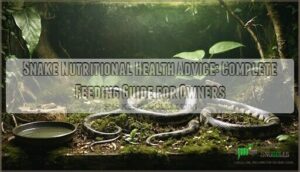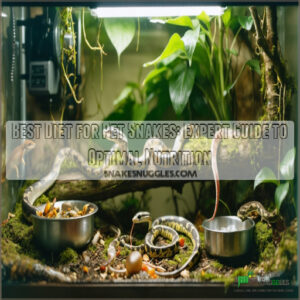This site is supported by our readers. We may earn a commission, at no cost to you, if you purchase through links.
 You’ll master snake nutritional health tips by focusing on whole prey items sized 1-1.5 times your snake’s thickest body section.
You’ll master snake nutritional health tips by focusing on whole prey items sized 1-1.5 times your snake’s thickest body section.
Feed juveniles weekly, adults every 2-3 weeks, using frozen-thawed rodents for safety.
Maintain basking temperatures of 85-95°F for proper digestion, and keep humidity at 50-60% for hydration.
Monitor your snake’s body condition regularly—you should feel slight muscle definition along the spine without prominent vertebrae showing.
Quality sourcing matters more than you’d think, as nutritionally-depleted prey leads to deficient snakes.
The secret lies in understanding how environmental factors directly impact nutrient absorption.
Table Of Contents
- Key Takeaways
- Snake Dietary Needs
- Feeding Techniques Safety
- Nutritional Requirements
- Environmental Factors
- Health Monitoring Tips
- Frequently Asked Questions (FAQs)
- How do you feed a snake a healthy diet?
- How do you keep a snake healthy?
- Is the snake diet a healthy choice?
- What are the best vitamins for a healthy snake?
- What do snakes eat?
- Are snakes healthy?
- What is the most nutritious food for snakes?
- How to keep your snake healthy?
- What should you not feed a snake?
- How often should I feed a malnourished snake?
- Conclusion
Key Takeaways
- Feed whole prey sized to your snake’s thickest body section – Use frozen-thawed rodents that measure 1-1.5 times your snake’s width, feeding juveniles weekly and adults every 2-3 weeks for optimal nutrition.
- Maintain proper environmental conditions for digestion – Keep basking temperatures at 85-95°F and humidity at 50-60% to ensure your snake can properly absorb nutrients from its food.
- Monitor your snake’s body condition regularly – Check monthly for healthy muscle tone along the spine without visible ribs or excessive fat deposits, adjusting feeding frequency as needed.
- Source quality prey from reputable suppliers – Choose frozen-thawed options from reliable sources to prevent disease transmission and ensure consistent nutritional value for your snake’s long-term health.
Snake Dietary Needs
Understanding your snake’s dietary needs starts with recognizing that these obligate carnivores require whole prey items to thrive, not just chunks of meat or commercial supplements.
Your snake needs whole prey, not processed alternatives—it’s nature’s perfect nutritional package.
You’ll need to match prey size to your snake’s body width and adjust feeding frequency based on age, with juveniles eating every 5-7 days while adults can go 1-4 weeks between meals depending on species.
Whole Prey Items Importance
The foundation of snake nutritional health lies in whole prey items that deliver nutrient completeness your snake can’t get elsewhere.
These complete meals provide balanced diet essentials, supporting bone health through natural calcium-to-phosphorus ratios.
Whole prey items trigger natural instincts while supplying digestive enzymes that processed foods lack, making them irreplaceable for ideal snake nutrition.
Prey Size and Type Selection
Selecting prey items correctly transforms your snake’s health from merely surviving to thriving. Appropriate size guarantees safe digestion, while prey variety delivers maximum nutritional value through diverse sourcing ethics and safe handling practices.
Captive snake diets benefit from occasional diet diversification for enrichment and nutrition.
- Size your prey to 1-1.5 times your snake’s thickest body part – measure before feeding to prevent regurgitation
- Offer rodent diet variety with mice, rats, and occasional chicks – frozen-thawed prey provides consistent nutrition
- Source whole prey from reputable suppliers – quality control prevents disease transmission to your snake
- Adjust prey items as your snake grows – juveniles need smaller, more frequent meals than adults
Feeding Frequency and Portion Control
Age-Based Feeding schedules vary dramatically across snake species and life stages.
Young snakes require feeding every 5-7 days, while adults eat every 1-3 weeks depending on size.
Prey Size Matters—match portions to your snake’s widest body section to prevent Overfeeding and maintain healthy body condition.
| Snake Age/Size | Feeding Frequency |
|---|---|
| Juveniles (0-1 year) | Every 5-7 days |
| Sub-adults (1-2 years) | Every 7-10 days |
| Adults (2+ years) | Every 10-21 days |
| Large species adults | Every 3-6 weeks |
Activity Level Impact and Seasonal Adjustments affect your feeding routine—active snakes need more frequent meals than sedentary ones.
Feeding Techniques Safety
How you feed your snake matters as much as what you feed them.
Proper feeding techniques protect both you and your snake from injury while ensuring they get the nutrition they need to thrive.
Frozen-Thawed Prey Handling
Most experienced keepers know that proper thawing methods make all the difference in your snake’s feeding response. Thaw frozen prey overnight in the refrigerator, never using microwaves or hot water that can create dangerous hot spots.
Warming techniques like lukewarm water baths bring frozenthawed prey to room temperature, mimicking live prey conditions. Always conduct thorough prey inspection for damage or off odors before feeding.
Safe handling with feeding tongs prevents accidental bites during snake food presentation, while understanding common rejection reasons helps troubleshoot feeding issues. Consider using specialized handling tools for safer feeding practices.
Live Prey Risks and Benefits
Live prey offers hunting stimulation for your snake’s natural instincts but carries significant injury potential.
Rodents can bite, scratch, or damage eyes and mouth, with up to 30% of cases requiring veterinary treatment. Disease transmission risks increase compared to frozen options.
Ethical concerns arise from prolonged prey suffering in captivity. Most experts recommend frozen-thawed feeding for snake health and safety.
High-quality nutrition is essential, so it’s important to source frozen prey responsibly for the well-being of your snake, ensuring you provide the best possible care with minimal risks.
Prey Quality and Sourcing
You’ll want healthy, parasite-free feeders from reliable suppliers to keep your snake in top shape. Ethical sourcing matters—choose suppliers who prioritize feeder health and proper gut loading practices.
- Verify supplier reliability through reviews and veterinary recommendations for consistent quality
- Request health certificates confirming parasite prevention protocols and nutritional standards
- Check frozen prey packaging for proper storage temperatures and expiration dates
- Ensure appropriate prey size matches your snake’s body width for safe digestion
- Confirm calcium-to-phosphorus ratios in whole prey meet species-specific nutritional requirements
Nutritional Requirements
Your snake’s nutritional success depends on balancing essential macronutrients and micronutrients for peak health. Understanding protein requirements, vitamin needs, and mineral ratios guarantees your pet thrives throughout its life.
Protein and Fat Balance
Within your snake’s carnivorous diet, protein sources should comprise roughly 62% of total intake, while fat metabolism requires around 17%.
Prey composition directly affects growth rates and energy storage capabilities. Whole rodents naturally provide this nutritional balance, supporting ideal protein and fat intake.
A proper calcium-phosphorus ratio is also essential for bone health.
Monitor your snake’s body condition monthly, adjusting prey size to maintain healthy snake nutritional health without creating a balanced diet imbalance.
Vitamin and Mineral Supplements
Most snakes thrive on whole-prey diets without needing snake vitamins or reptile supplements.
However, certain situations require veterinary guidance for proper mineral balance and D3 synthesis support. Many owners buy snake vitamin supplements for their pets.
- Supplement overdosing can cause toxicity, especially with fat-soluble vitamins
- Species needs vary – piscivorous snakes may need thiamine supplementation
- Calcium absorption relies on adequate vitamin D3 from dietary sources
- Vitamin and mineral needs are typically met through quality whole prey
- Reptile supplements should only be used when deficiencies are confirmed
Calcium and Phosphorus Ratio
Maintaining the correct calcium to phosphorus ratio of 2:1 helps prevent metabolic bone disease in your snake.
Whole prey like rodents naturally provide this balance, while feeder insects require calcium supplementation.
Species variation exists, with juveniles needing higher ratios up to 7:1, and it is crucial to watch for deficiency signs including lethargy, bone deformities, and muscle fasciculations.
Supplementation risks include overdosing, so consult your veterinarian first.
Environmental Factors
Your snake’s environment directly affects how well it processes nutrients and maintains prime health.
The right temperature, humidity, and lighting conditions work together to guarantee your snake can properly digest food, absorb essential vitamins, and stay hydrated throughout its life.
Temperature and Digestion Relationship
Temperature control dictates your snake’s digestive success.
Cold snakes can’t digest food—proper heat zones ensure nutrient absorption and prevent dangerous regurgitation.
Cold snakes can’t process food properly, leading to dangerous regurgitation or bacterial growth.
You’ll need a proper heat gradient with basking spots reaching 88-95°F and cool areas around 78-80°F.
Different heating methods like under-tank heaters or ceramic bulbs create digestion zones that promote healthy eating.
Monitor basking behavior to confirm your snake finds comfortable temperatures for efficient nutrient absorption.
Snakes’ flexible jaws enable swallowing large prey, a key aspect of their feeding strategy.
Humidity Impact on Hydration
Proper humidity creates the foundation for ideal snake hydration, directly affecting respiratory health and preventing dehydration signs.
You’ll need to maintain 50-60% humidity levels to support skin health and prevent shedding difficulties that compromise your snake’s well-being.
- Monitor humidity with digital hygrometers placed at cool and warm ends
- Provide fresh water availability in appropriately sized, spill-resistant bowls
- Increase humidity during shedding periods to prevent water retention issues
- Watch for dehydration signs like wrinkled skin or sunken eyes
- Adjust ventilation to balance humidity and hydration without creating stagnant air, ensuring proper ventilation and ideal snake hydration, which are crucial for preventing dehydration signs.
Lighting and Vitamin D3 Synthesis
Beyond humidity’s role in hydration, UVB lighting triggers vitamin D3 synthesis in your snake’s skin.
UVB exposure converts 7-dehydrocholesterol to vitamin D3, supporting calcium absorption and preventing metabolic bone disease.
Many keepers purchase specialized UVB bulbs for their reptiles.
Nocturnal species still benefit from proper lighting schedules.
| UVB Requirements | Recommended Setup |
|---|---|
| Light Type | T5/T8 strip lights over coil bulbs |
| Ferguson Zone | Zone 1-2 (UVI 0-1.0) for most species |
| Daily Schedule | 10-12 hours matching natural cycles |
| Bulb Replacement | Every 6-12 months as output declines |
| Positioning | Near basking spots for ideal exposure |
Health Monitoring Tips
Keeping your snake healthy requires regular monitoring of their body condition and eating habits.
You’ll need to watch for signs of nutritional problems and adjust their care routine based on what you observe.
Monitoring Body Condition
Regular assessments reveal vital health patterns.
Check your snake’s weight monthly using a digital snake weight scale, watching for gradual weight fluctuation rather than dramatic changes.
Examine muscle tone along the spine—healthy snakes show firm, rounded bodies without visible ribs or excessive fat deposits.
Monitor shedding issues, hydration signs like skin elasticity, and conduct basic fecal analysis.
Snake obesity develops slowly, making consistent weight monitoring essential for early detection and effective portion size control through proper snake body scoring techniques, which help in early detection and ensure the snake’s overall health patterns are maintained.
Adjusting Feeding Schedules
Feeding schedules aren’t set in stone—they’re living documents that evolve with your snake’s needs.
Seasonal adjustments matter since many species slow down during winter months, requiring less frequent meals. Growth spurts in juveniles demand increased meal frequency, while breeding season may suppress appetite entirely.
Monitor your snake’s shedding cycle and activity levels closely, as these directly impact nutritional needs.
Age-specific diet modifications and species-specific scheduling guarantee the best health throughout your snake’s lifetime. Remember that snake age affects frequency, which is a critical factor in determining the optimal feeding schedule for your snake, ensuring its overall well-being.
Recognizing Nutritional Deficiencies
Watch for telltale deficiency symptoms that signal nutritional problems in your snake.
Lethargy, muscle tremors, and persistent anorexia often indicate calcium deficiency or vitamin imbalances.
Behavioral changes like neurological issues, head tilting, or seizures suggest thiamine deficiency, especially in fish-eating species.
Shedding issues, swollen eyelids, and weight loss point to vitamin A deficiency requiring immediate veterinary diagnosis and supplement needs adjustment.
Maintaining Proper Hydration Levels
Proper hydration keeps your snake healthy and supports smooth shedding cycles.
Always provide fresh water in a clean bowl, checking daily for debris or contamination.
Watch for dehydration signs like wrinkled skin, sunken eyes, or difficulty shedding.
Maintain humidity control between 50-60% to prevent kidney problems and guarantee adequate water availability throughout your snake’s enclosure, ensuring proper hydration and supporting smooth shedding cycles.
Frequently Asked Questions (FAQs)
How do you feed a snake a healthy diet?
Like a well-oiled machine, you’ll thrive by offering frozen-thawed prey matching your snake’s body width. Feed juveniles weekly, adults bi-weekly. Maintain proper temperatures for digestion and provide fresh water always.
How do you keep a snake healthy?
You’ll master snake health by maintaining proper temperatures (78-88°F), humidity (50-60%), and feeding schedules. Provide fresh water, appropriate prey sizes, and monitor body condition monthly for ideal wellness.
Is the snake diet a healthy choice?
Unless you’re a literal snake, the "snake diet" fad isn’t healthy for humans.
You’ll lack essential nutrients, risk malnutrition, and won’t meet your body’s complex dietary needs like actual snakes do, because the diet fails to provide what is necessary for human health.
What are the best vitamins for a healthy snake?
Your snake doesn’t need additional vitamins if you’re feeding whole prey like mice or rats.
These provide complete nutrition, including essential calcium, vitamin D3, and trace minerals naturally.
Only supplement under veterinary guidance.
What do snakes eat?
Carnivorous reptiles require whole prey like mice, rats, or birds depending on their species.
You’ll need to match prey size to your snake’s width, feeding juveniles every 5-7 days and adults weekly or biweekly.
Are snakes healthy?
Absolutely incredible how resilient these reptiles are! You’ll find snakes remarkably healthy when you provide proper nutrition, temperatures, and care. Their simple needs make them surprisingly robust pets.
What is the most nutritious food for snakes?
Whole prey like mice and rats provides complete nutrition for your snake.
They contain balanced protein, fats, calcium, phosphorus, and essential vitamins that support healthy growth, digestion, and immune function naturally.
How to keep your snake healthy?
Research shows 85% of snake health issues stem from improper husbandry.
You’ll maintain your snake’s health by providing species-appropriate prey every 1-2 weeks, maintaining 78-88°F temperatures, ensuring 50-60% humidity, offering fresh water constantly.
Monitoring body condition monthly is crucial for ideal wellness, and by following these guidelines, you can ensure your snake stays healthy.
What should you not feed a snake?
Never feed your snake processed foods, vegetables, fruits, dairy, or cooked meats. Avoid insects for most species, spoiled prey, or anything containing bones that could splinter and cause internal injuries.
How often should I feed a malnourished snake?
Don’t rush recovery thinking faster equals better—malnourished snakes need careful rehabilitation. Feed every 5-7 days with appropriately sized prey, gradually increasing portions as body condition improves under veterinary guidance.
Conclusion
Like a carefully calibrated clock, successful snake keeping requires precise timing and attention to detail.
These snake nutritional health tips form the foundation of responsible reptile ownership. You’ll create thriving conditions by matching prey size to your snake’s girth, maintaining proper temperatures for digestion, and monitoring body condition regularly.
Remember that environmental factors directly influence nutrient absorption—temperature, humidity, and quality sourcing can’t be overlooked. With consistent application of these principles, you’ll guarantee your snake maintains peak health throughout its life, ensuring a long and healthy relationship through responsible reptile ownership.
- https://www.northgateveterinary.com/site/blog/2022/06/15/what-snakes-eat
- https://talis-us.com/blogs/news/5-nutritional-requirements-for-a-healthy-snake-pet-diet
- https://www.chewy.com/education/reptile-and-amphibian/snake/what-do-snakes-eat
- https://vettoday.com/blog/pet-health/how-often-do-snakes-eat/
- https://thetyedyediguana.com/blog/how-often-should-my-snake-eat/














